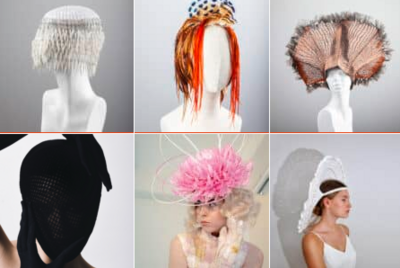Welcome at the Interface Culture program website.
Acting as creative artists and researchers, students learn how to advance the state of the art of current interface technologies and applications. Through interdisciplinary research and team work, they also develop new aspects of interface design including its cultural and social applications. The themes elaborated under the Master's programme in relation to interactive technologies include Interactive Environments, Interactive Art, Ubiquitous Computing, game design, VR and MR environments, Sound Art, Media Art, Web-Art, Software Art, HCI research and interaction design.

The Interface Culture program at the Linz University of Arts Department of Media was founded in 2004 by Christa Sommerer and Laurent Mignonneau. The program teaches students of human-machine interaction to develop innovative interfaces that harness new interface technologies at the confluence of art, research, application and design, and to investigate the cultural and social possibilities of implementing them.
The term "interface" is omnipresent nowadays. Basically, it describes an intersection or linkage between different computer systems that makes use of hardware components and software programs to enable the exchange and transmission of digital information via communications protocols.
However, an interface also describes the hook-up between human and machine, whereby the human qua user undertakes interaction as a means of operating and influencing the software and hardware components of a digital system. An interface thus enables human beings to communicate with digital technologies as well as to generate, receive and exchange data. Examples of interfaces in very widespread use are the mouse-keyboard interface and graphical user interfaces (i.e. desktop metaphors). In recent years, though, we have witnessed rapid developments in the direction of more intuitive and more seamless interface designs; the fields of research that have emerged include ubiquitous computing, intelligent environments, tangible user interfaces, auditory interfaces, VR-based and MR-based interaction, multi-modal interaction (camera-based interaction, voice-driven interaction, gesture-based interaction), robotic interfaces, natural interfaces and artistic and metaphoric interfaces.
Artists in the field of interactive art have been conducting research on human-machine interaction for a number of years now. By means of artistic, intuitive, conceptual, social and critical forms of interaction design, they have shown how digital processes can become essential elements of the artistic process.
Ars Electronica and in particular the Prix Ars Electronica's Interactive Art category launched in 1991 has had a powerful impact on this dialog and played an active role in promoting ongoing development in this field of research.
The Interface Cultures program is based upon this know-how. It is an artistic-scientific course of study to give budding media artists and media theoreticians solid training in creative and innovative interface design. Artistic design in these areas includes interactive art, netart, software art, robotic art, soundart, noiseart, games & storytelling and mobile art, as well as new hybrid fields like genetic art, bioart, spaceart and nanoart.
It is precisely this combination of technical know-how, interdisciplinary research and a creative artistic-scientific approach to a task that makes it possible to develop new, creative interfaces that engender progressive and innovative artistic-creative applications for media art, media design, media research and communication.
Gut behütet – Kopfbedeckungen neu gedacht
Ausstellung bis 15. Juni 2025 Handwerksmuseum, Maria-Ward-Platz 1, 94469 Deggendorf (DE)
Ausstellungsbeteiligung von Beatrix Kaufmann
Hüte sind weit mehr als funktionale Kleidungsstücke – sie sind kulturelle Artefakte, die Geschichten von Macht, Wandel und Kreativität erzählen. Ihre Formen und Bedeutungen mögen sich im Laufe der Jahrhunderte verändert haben, doch ihre Rolle als Ausdruck von Identität und Stil bleibt ungebrochen.
Groß oder klein, klassisch, poppig oder extravagant; Die ausgestellten Kopfbedeckungen haben alle Farben, Formen und Materialien, wie Holz, Glas oder Keramik und sind vielseitig einsetzbar; ob Hüte als Sonnenschutz oder zur Zierde, schützende Kopfbedeckungen, eine Mischung aus Kopf- und Gesichtsbedeckung, oder auch raffinierte Perücken sind im Handwerksmuseum präsentiert.
10. Wettbewerb für Handwerk und Design
Für den Wettbewerb für Handwerk und Design 2025 mit dem Thema „Gut behütet – Kopfbedeckungen neu gedacht“ bewarben sich 119 Kunsthandwerker*innen und Designer*innen mit 187 Kopfbedeckungen. 70 Kopfbedeckungen von 42 Bewerbenden wurden ausgewählt, die nun in der Ausstellung zu sehen sind.
1. Preis: Edith Berger mit „AB_WESEN“
2. Preis: Maurizio Paul Hirmer mit „Neutralisierungs-Hybrid“
3. Preis: Silvia Fedorová mit „Strahlen“
3. Preis: Heike Thamm mit „Helmpflicht: Norfolk und Suffolk“
Belobigung: Franziska Maria LaPlante (geb. Pruckner) mit „Unter die Haube – Linzer Goldhaube reworked“
Kopfbedeckungen folgender Personen sind ausgestellt:
Edith Berger, Lucia Bochow, Gina Bockisch, Nora Bregulla, Anna Brock, Sabine Combé, Helen Efe Doghor-Hötter, Franziska Eberle, Christiane Engelsberger, Melina Grgic, Anna Schneider, Valentin Schenk, Huda Al Ahdab, Christoph Helden, Verena Fink, Marie Göhler, Bettina Graber-Reckziegel, Helga Grübl, Sandra Grünberger, Alexandra Harizanová, Maurizio Paul Hirmer, Philipp Hoelzgen, Ye Jun-Xiang, Ruby Jurkeit, Beatrix Kaufmann, Birgit Kerber, Klaus Kirchner, Stefanie Kröninger, Doris Limmer, Flora Lottner, Sophia Neidhart, Anna Normand, Franziska Maria Pruckner, Nada Quenzel, Kathrin Ringlstetter, Britta Roßmüller, Christina Schlumberger, Hanna Schmitt, Susanne Schmitt, Alexander Seitz, Heike Thamm, Michael Weinfurtner, Elke Zahn
handwerksmuseum.deggendorf.de/2025-gut-behuetet-kopfbedeckungen-neu-gedacht
